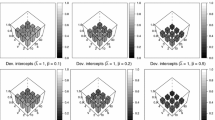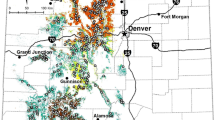Abstract
The distribution of sample units in multivariate species space typically departs strongly from the multivariate normal distribution. Instead of forming a hyperellipse in species space, the sample points tend to lie along high-dimensional edges of the space. This dust bunny distribution is seen in most ecological community datasets. The practical consequences of the distribution to the analysis of community data are well known and severe, but no one has demonstrated how population processes generate these problems. We evaluate potential causes of dust bunny distributions by simulating a large number of non-equilibrial communities under varying conditions, verifying that they resemble real data, then analyzing the relationship between the intensity of the dust bunny distribution in these datasets and the population and environmental parameters that gave rise to them. All community datasets, both simulated and real, departed strongly from multivariate normal and lognormal distributions. Four parameters influenced intensity of dust bunnies: time since community-replacing disturbance, number of environmental factors, dispersal limitation, and niche width. Samples measured soon after community-replacing disturbance had strong dust bunny distributions. Near-equilibrial communities sampled from a narrow range in environments lead to only weak dust bunnies. Community samples taken across multiple simultaneous strong environmental gradients are likely to show strong dust bunnies, regardless of the successional state, niche width of the component species, and degree of dispersal limitation. Dust bunny intensity depends not only on population processes and disturbance, but also on the properties of the sample, such as sample unit area or volume.




Similar content being viewed by others
References
Anderson MJ (2001) A new method for non-parametric multivariate analysis of variance. Aust Ecol 26:32–46
Anderson MJ, Crist TO, Chase JM, Vellend M, Inouye BD, Freestone AL, Sanders NJ, Cornell HV, Comita LS, Davies KF, Harrison SP, Kraft NJB, Stegen JC, Swenson NG (2011) Navigating the multiple meanings of β diversity: a roadmap for the practicing ecologist. Ecol Lett 14:19–28
Beals EW (1973) Ordination: mathematical elegance and ecological naivete. J Ecol 61:23–35
Beals EW (1984) Bray–Curtis ordination: an effective strategy for analysis of multivariate ecological data. Adv Ecol Res 14:1–55
Bliss CI, Fisher RA (1953) Fitting the negative binomial distribution to biological data. Note on the efficient fitting of the negative binomial. Biometrics 9:176–200
Bray JR, Curtis JT (1957) An ordination of the upland forest communities in southern Wisconsin. Ecol Monogr 27:325–349
Cassie RM (1962) Frequency distribution models in the ecology of plankton and other organisms. J Anim Ecol 31:65–92
Clarke KR (1993) Non-parametric multivariate analyses of changes in community structure. Aust J Ecol 18:117–143
Freestone AL, Inouye BD (2006) Dispersal limitation and environmental heterogeneity shape scale-dependent diversity patterns in plant communities. Ecology 87:2425–2432
Gaston KJ, McArdle BH (1994) The temporal variability of animal abundances: measures, methods and patterns. Phil Trans R Soc Lond B 345:335–358
Gauch HG (1982) Noise reduction by eigenvector ordination. Ecology 63:1643–1649
Goodall DW (1963) The continuum and the individualistic association. Vegetatio 11:297–316
Hubbell SP (2001) The Unified Neutral Theory of Biodiversity and Biogeography. Monographs in Population Biology 32. Princeton, New Jersey
Kruskal JB (1964) Multidimensional scaling by optimizing goodness of fit to a nonmetric hypothesis. Psychometrika 29:1–27
Legendre P, Legendre L (1998) Numerical ecology, 2nd edn. Elsevier, Amsterdam
McCune B (2006) Non-parametric habitat models with automatic interactions. J Veg Sci 17:819–830
McCune B, Allen TFH (1985) Will similar forests develop on similar sites? Can J Bot 63:367–376
McCune B, Grace JB (2002) Analysis of ecological communities. MjM Software, Gleneden Beach
McCune B, Mefford MJ (2011) PC-ORD. Multivariate analysis of ecological data. Version 6.08. MjM Software, Gleneden Beach
Peck JE (2010) Multivariate analysis for community ecologists. Step-by-step using PC-ORD. MjM Software Design, Gleneden Beach
Ricklefs RE (1987) Community diversity: relative roles of local and regional processes. Science 235:167–171
Sousa WP (1984) The role of disturbance in natural communities. Ann Rev Ecol Syst 15:353–391
Spinoza B (1677) The ethics. Part I, Proposition XV, note. Transl. R. H. M. Elwes. University of Adelaide eBooks, New York
Tuomisto H (2010) A diversity of beta diversities: straightening up a concept gone awry. Part 2. Quantifying beta diversity and related phenomena. Ecography 33:23–45
Whittaker RH (1972) Evolution and measurement of species diversity. Taxon 21:213–251
Whittaker RH, Gauch HG Jr (1973) Evaluation of ordination techniques. Handb Veg Sci 5:287–321
Acknowledgments
We dedicate this paper to David Goodall and his foundational work in ecology. We thank contributors of data; students and colleagues for helpful discussion, Dave Roberts for sharing a draft chapter on schools of community ecology, Amy Charron for dust bunny drawings, and Stéphane Dray, Andy Jones, Lisa Madsen, Patricia Muir, and anonymous reviewers for critiquing the manuscript.
Author information
Authors and Affiliations
Corresponding author
Additional information
Communicated by P.R. Minchin and J. Oksanen.
Electronic supplementary material
Below is the link to the electronic supplementary material.
Rights and permissions
About this article
Cite this article
McCune, B., Root, H.T. Origin of the dust bunny distribution in ecological community data. Plant Ecol 216, 645–656 (2015). https://doi.org/10.1007/s11258-014-0404-1
Received:
Accepted:
Published:
Issue Date:
DOI: https://doi.org/10.1007/s11258-014-0404-1




